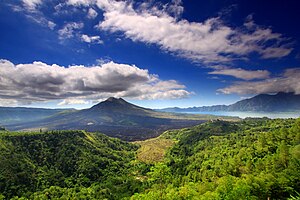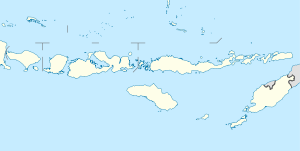Batur (volcano)
| Batur | ||
|---|---|---|
|
In the middle of the Batur from the south, on the right the crater lake |
||
| height | 1717 m | |
| location | Bali , Indonesia | |
| Coordinates | 8 ° 14 '18 " S , 115 ° 22' 39" E | |
|
|
||
| Type | Caldera | |
| Last eruption | 2000 | |
|
on the left the Gunung Agung , on the right the calderas of the Batur |
||
The Batur is an active stratovolcano in the center of two concentric calderas in the Bangli district on the Indonesian island of Bali .
The larger caldera, measuring 10 by 13.5 kilometers, was created around 29,300 years ago. The 6.4 by 9.4 km inner caldera is dated to an age of around 20,150 years. Ignimbrites were deposited in the two eruptions that led to the formation of the calderas . Subsequently, the stratovolcano Batur emerged in the inner caldera. Large parts of the outer rim of the caldera are lower than the 1717 meter high Batur; Gunung Abang, 2159 meters high, towers above the area only in the southeast. In the southeast of the larger caldera is the Danau Batur crater lake . Almost 20 kilometers southeast of the Batur is the Agung , a volcano that last erupted in 2018.
Numerous eruptions of the Batur are known from historical times: In 1905 a lava flow from a crater on the western slope of the Batur in a built-up area came to a standstill. After a series of smaller eruptions since 1921 of Batur opened in August 1926 south, a column , exiting the lava and showered large parts of the village Batur. In September 1963, lava was extracted from several vents west of the summit and flowed south and west. The last eruption of the Batur between March 1999 and June 2000 resulted in ash eruptions and smaller explosions in the summit area.
Between November 2009 and November 2010, the warning level for the Batur was raised from “Normal” to “Vigilant” after the number of earthquakes had increased significantly.
The caldera is inhabited by around 16,000 people who live in the villages of Kedisan and Toya Bungkah, among others. On the western edge of the caldera is the street village of Kintamani , eight kilometers to the south a winding road branches off into the caldera in Penelokan. On the eastern shore of the lake is the Bali Aga village of Trunyan with a cemetery where the dead are buried under bamboo frames on the ground. In addition to traditional agriculture, which is mainly practiced on the fertile outer slopes of the caldera, tourism is an important source of income for the residents.
Web links
- Batur in the Global Volcanism Program of the Smithsonian Institution (English)
Individual evidence
- ^ Batur in the Smithsonian Institution's Global Volcanism Program (accessed February 6, 2013).
- ^ Christopher G. Newhall, Daniel Dzurisin: Historical unrest at large calderas of the world . USGS Bulletin 1855, 1988 (English, pdf, 37.0 MB), p. 321f.
- ↑ Monthly report 10/2000 and 09/2001 in the Global Volcanism Program (accessed on February 6, 2013).
- ↑ Weekly reports November 2009 and November 2010 in the Global Volcanism Program (accessed on February 6, 2013).


